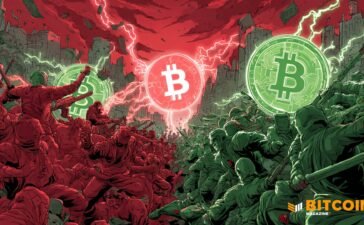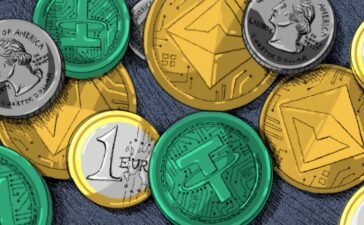
Introduction
Names can be both liberating and confining. When mankind gives something a name, we mark it with a label that helps us discuss our shared environment and experience. At the same time, a label can obscure something in preconceived notions. Labels can make it more difficult for us collectively to understand what something is.
In 2008, a pseudonymous inventor named Satoshi Nakamoto released a white paper titled “Bitcoin: A Peer-to-Peer Electronic Cash System”1. The paper outlines a novel distributed network system, called Bitcoin, that acts as an immutable digital ledger. There are many ways to describe what the fundamental innovation here really was. For the context of this article, perhaps it is best to describe the innovation as the creation of a computer system that controls a database, which can only be added to or modified depending on the quantity of physical energy (in the form of electricity) supplied to it. Unlike standard computer systems, where linguistic logic coded by a programmer dictates the state of 0s and 1s, this machine changes when it is fed energy from the Earth.
Integrating physical energy into the operations of the computer network was a pivotal moment for the possibility of creating digitally native money. Nick Szabo, in his work “Shelling Out: The Origins of Money,” provides an anthropological interpretation of how the use of money developed2. In trade, two potentially untrusting parties must find a way to trust one another. To do so, we can rely upon tokens of record that are governed by the laws of nature, which we all can trust. A commodity can be a helpful medium of exchange when it is scarce and hard to reproduce to the degree that people understand the extreme amount of energy and effort it would take to counterfeit one. Scarcity is how homo-sapiens detect the energy required to obtain a given object, giving it trust and validity as a unit of record. The greater the energy, the more desired and valuable it is in our endeavors to cooperate and trust one another. From this point of view, Bitcoin fits this description perfectly, it requires energy to produce and therefore is an immutable record that can be used as powerful money.
However, as this distributed system evolves, it has become evident that the Bitcoin network does more than simply produce a digital, yet scarce, asset called bitcoin that can be used as money. For this reason, it may be helpful to momentarily give Bitcoin another name to reanalyze the broader function of this machine. For now, let us call it an entropy engine instead.
Entropy
Entropy is a complicated word that can be articulated in many ways. To begin, consider the equation:
S = kB x lnΩ
S, meaning entropy, equals Boltzmann constant (k) times the natural log of the number of particles (Ω) contained within a system3. Entropy can be described as the quantity of available states a system can have. If there is a big container with many molecules, it will have many more possible configurations than a smaller container with fewer molecules. The more particles the container has, the more variations there are in how the molecules can be arranged. According to the second law of thermodynamics, total entropy in an isolated system cannot decrease, but can only increase. Therefore, because entropy always increases, all the molecules eventually find the most likely arrangement, which is them all being spread out equally. This is known as thermodynamic equilibrium, and the universe tends towards this. The continuous increase in entropy is a law of nature.
Due to entropy’s relationship with possible states, it is also related to randomness. Additionally, it is associated with heat loss. The second law of thermodynamics indicates that when one kind of energy is converted to another type of energy, there will inevitably be some heat loss. The conversion is never 100% efficient. Rub your hands together very quickly, and you will notice that the friction creates heat. This is you contributing to the increase in entropy of the universe.
This new computer system is an entropy engine because it produces both randomness and heat. To add new transactions to the blockchain, a computer running the software must make many guesses until it finds a hash value with a certain number of leading zeroes. The quicker the machine can produce more random guesses, the more likely the machine is to be rewarded with bitcoin. The more randomness the machine can create, the better it functions and the more heat it produces. This machine involves all things entropy.
The users of the machine also benefit from the entropy machine more if they can harness more entropy. The mathematics of entropy is foundational to the science of cryptography. Another way of interpreting the equation above, in terms of informational entropy, is that the more particles in a container represent the amount of information needed to understand the state of the system3. Put another way, the more possible states and complexity a system has, the more information one would need to gain an understanding of it. Consequently, more entropy represents more inherent uncertainty or surprise an event might have3. The entropy engine relies upon public-private key cryptography. A system user will have a public key where they receive bitcoin. At the same time, only they can send their bitcoin because they have the private key, which cannot be derived from the public key. The safe ownership of bitcoin relies upon an individual keeping their private key secret. Cryptographic schemes rely upon the assumption of highly random private keys3. In other words, the more randomness used to form a private key, the more secure one can protect their property on the network. Both the maintainers and users of the network utilize entropy for their benefit.
Life is in Pursuit of Entropy
Not only is this system an entropy engine from a technical point of view, but it can also be viewed as a driver of entropy from a societal point of view. The flow of human civilization can be reconciled with the observation that biological life facilitates the increase of entropy. Imagine a bathtub drain: once the drain plug is pulled, the water within the tub wants to flow down into the drain. Think of this as the universe’s tendency towards higher entropy. An orderly and sustained vortex will form at the drain to facilitate this transition expediently. Order develops to absorb and dissipate the energy, speeding up the process of generating more entropy more efficiently. Order, life, and all the complexity on Earth form to expedite the increase of entropy further as the sun transfers energy to the Earth. Plants grow to absorb sunlight and store the energy within themselves, and animals eat those plants to process the energy further, etc. Now consider the tell-tale sign of someone alive: their body is warm. Our body processes energy and dissipates some continuously as heat. Life forms in pursuit of entropy.
Our society moves forward when we learn to find more efficient ways to harness and dissipate energy on Earth. A classic discovery we take pride in was our ability to release the energy stored in wood into fire, producing heat. We then learned to release stored energy within coal and then oil; eventually, we harnessed energy from wind and sunlight and finally upgraded to releasing the energy of atoms themselves. We absorb energy (in the form of wood, coal, oil, sunlight, wind, etc.) only to dissipate it for our gain. In the meantime, our society prospers and experiences excellent technological leaps forward as we learn to harness more advanced forms of energy. As we use the energy, heat loss occurs, and entropy increases. We act as the vortex: order that expedites the process.
Humanity’s fundamental drive is to find and release pockets of stored energy. Interestingly, the entropy engine seems to provide an extra nudge, pushing humanity in this direction to a greater degree. Consider an undeveloped village with no electric infrastructure but near a river where a dam could be built. An ambitious entrepreneur may be interested in making a dam, but the capital expense is high. Additionally, it is not as if the nearby village will immediately purchase all modern electrical luxuries once the dam is built. At most, perhaps each home will gladly buy a lightbulb so their child can study school work after sundown. Though life-changing for the community, the revenue from one lightbulb a night per home is not enough to justify the capital expenditure of the dam. Before the invention of an entropy engine, many areas of the world would be without electricity for similar kinds of reasons. Now, an entropy engine operator is willing to purchase all unused electricity from the dam because cheap electricity leads to profit. The new customer provides a constant and complete excess inventory purchase of electricity for the dam. Suddenly, building a dam becomes economically viable. Before Satoshi’s invention, there were energy sources on Earth that humans did not yet have the financial means to harness. Suddenly, the pockets of energy become viable by inventing an entropy engine, and our harnessing of them multiplies.
Not only does the business model of an entropy engine operator make previously unaffordable energy infrastructure affordable, but it also helps incentivize the development of renewable energy over the usage of less desirable fossil fuels. Energy grids require flexibility due to the electricity demand. The supply of electrons sent to a city needs to equal the demand for electricity at that time. Of course, a city’s demand for electricity will fluctuate throughout the day and year. An electrical grid needs to be able to dial up and down energy production in response. Currently, there are not enough batteries to store energy when it is not required. This challenges the development of renewable energy infrastructure, especially wind and solar, because nature decides when energy is produced, irrespective of the city’s electrical needs. If energy is not used, it is curtailed and wasted. If not enough is being produced, the city is without power. One reason fossil fuels are so helpful for grid stabilization is that production can be easily changed immediately depending on electricity demand. Of course, this problem could be mitigated if enough renewables were developed that could constantly produce more energy than peak demand. However, this would leave the energy providers without a customer for their excess electricity most of the time, making it financially unviable. Entropy engine operators can then incentivize renewable energy development by acting as a flexible load response that provides shock-absorbing services while increasing profitability in exchange for cheap electrical costs during times of excess supply4. Whatever electricity is not sent to the city is purchased by the entropy engine operators, making the capital investment in renewable infrastructure more economically viable. The same goes for nuclear energy, as these systems also struggle to conduct demand response on their own4. Therefore, research has shown that entropy engine operators provide additional revenue sources to incentivize renewable energy production and a greener grid4,5.
Entropy: The Cause of War, and Now Peace
Human civilization’s relationship with entropy and the entropy engine does not simply confine itself to how we are driven to harness, release, and use energy from a societal standpoint. It can also be looked at from a socio-political point of view. In a thesis titled Softwar: A Novel Theory of Power Projection and the National Strategic Significance of Bitcoin by Major Jason P. Lowery of the United States Space Force, a description of how energy organizes around the laws of entropy is used to explain the pattern of human behavior around warfare6. Power projection theory describes how life formed, per the second law of thermodynamics, by using energy (referred to as power) to sequester other energy (referred to as resources) away from the environment to be used for more personal gain. It is another way of describing how order was formed to facilitate the increase in entropy. This can be observed not only in the first prokaryotic cells that formed in the hydrothermal vents that exist in the fissures of the seafloor but also in the way animals behave in the wild. Major Lowry uses the illustration of wolves snarling their fangs at a would-be thief of their recently acquired game to broadcast that the cost of stealing the resources would be higher than the benefit gained from the food. Here, the wolf is projecting power to keep its resources. Following such reasoning, pack animals such as wolves must create power hierarchies within their communities so that the most powerful wolf, most capable of efficient power projection, is fed and allowed to reproduce so that the pack can have the most power projection capabilities possible to protect their resources. To do so, wolves must physically fight amongst themselves in a competition of dominance. This is an unfortunate requirement, as two wolves will fight until one wolf has their fangs on the jugular of the other to prove superiority6. Therefore, the physicality required to create power hierarchies can prove dangerous and fratricidal. Other animals, such as deer, solve this issue with the development of antlers which allows them to use their antlers as power projection weapons against other species but leads to safe competition within their species as the antlers simply tangle as they butt heads without the risk of mortal wounds. In this way, the deer developed a biological method of managing internal power hierarchies using physical power with a decreased risk of fratricide.
Major Lowry puts forth the idea that human beings, through language and storytelling, developed a form of abstract power projection in an attempt to organize resources without physical violence6. However, the universe tends toward increasing entropy, and physical energy is used to manage resource energy. Nature does not recognize the management of resources through any other means aside from physical energy. Therefore, human beings are stuck in a problematic cycle where we attempt to organize our societies and resources through abstract power projection, only to have them collapse under the weight of their hollow foundation through physical power projection. To our understandable discontent and frustration, war, civil war, and revolutions are constantly occurring as nature’s only proper mechanism of organizing resources. Though a bleak outlook on how humans must manage themselves, Major Lowry provides hope that the technological innovation of an entropy engine solves this crucial flaw in how our societies organize. The entropy engine is a means of managing resources using physical power. In other words, it acts as a technological antler allowing human beings to organize themselves following the laws of nature without the need for kinetic violence and fratricide. Rather than mutually assured destruction through nuclear warfare, the entropy engine promotes mutually assured protection as we all use the machine to protect our resources and each other simultaneously.
Conclusion
The operation of this distributed entropy engine relies upon the competitive production of entropy. Its users can secure their property most when using machines that produce the most entropy. It economically incentivizes, subsidizes, and makes possible the harnessing of previously untapped energy resources of the Earth. It also potentially reduces our need to fight wars in pursuit of resource acquisition because it allows us to compete over resources via other, more peaceful means. This entropy engine, Bitcoin, is accelerating human beings in fulfilling their cosmic purpose of facilitating energy flow in the universe. All while making society more resource-abundant, peaceful, and cooperative. If the second law of thermodynamics is inevitable, what does that make Bitcoin?
References
1. Nakamoto S. Bitcoin: A Peer-to-Peer Electronic Cash System. Accessed November 16, 2021. www.bitcoin.org
2. Szabo N. Shelling Out: The Origins of Money. Satoshi Nakamoto Institute. Published 2002. Accessed April 19, 2023. https://nakamotoinstitute.org/shelling-out/
3. Zolfaghari B, Bibak K, Koshiba T. The Odyssey of Entropy: Cryptography. Entropy. 2022;24(2). doi:10.3390/e24020266
4. Prescott S, Rudd MA, Ignacio Ibañez J, Freier A. Bitcoin’sBitcoin’s Carbon Footprint Revisited: Proof of Work Mining for Renewable Energy Expansion. Challenges 2023, Vol 14, Page 35. 2023;14(3):35. doi:10.3390/CHALLE14030035
5. Rhodes JD, Deetjen T, Smith C. Impacts of Large, Flexible Data Center Operations on the Future of ERCOT. Published online 2021.
6. Lowry J. Softwar: A Novel Theory on Power Projection and the National Strategic Significance of Bitcoin: Lowery, Jason Paul: 9798371524188: Amazon.Com: Books. Massachusetts Institute of Technology; 2023.
This is a guest post by Sydney Bright. Opinions expressed are entirely their own and do not necessarily reflect those of BTC Inc or Bitcoin Magazine.






